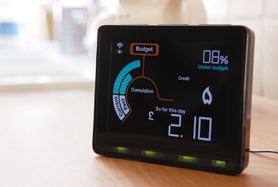 Eon has committed to ending standard variable tariffs (SVTs) energy tariffs by default.
Eon has committed to ending standard variable tariffs (SVTs) energy tariffs by default.
SVTs offer poor value compared to fixed-term deals and energy firms are under political pressure to scrap them.
The company said it will end SVTs for customers that already have a smart meter or agree to have one installed.
“We believe standard variable tariffs have had their day,” said Eon chief executive Michael Lewis, who took over the top job from Tony Cocker in April.
“Tomorrow is about helping customers engage with the market with tariffs that work for them. We want to take action now to make that happen for our customers and we’ll work with Ofgem and BEIS over the coming months to make this a reality.

“For us, smart meters are a key means to achieve this move because they represent a natural opportunity for engagement with our customers and the new technology opens up a world of more accurate billing and greater choice. We’ll be ramping up our activity next year so we’re able to start taking thousands of people off standard variable tariff each week – added to which, their smart future will begin with a price drop,” Lewis continued.
The company said it had installed around a million smart meters – up from around 750,000 in February.
However, the move “isn’t only about smart metering customers”, said Lewis.
“We’ll also be working on options for classic meter customers joining us or coming to the end of fixed term tariffs. This is about increasing engagement with customers and having better conversations about what they need from their energy supplier, making sure they have the tools and the knowledge to choose a tariff that best suits their needs.”
Smart move
The announcement is interesting. It outflanks the threat of regulatory intervention to prevent energy companies charging some customers more than others for the same product by default.
Equally, by stating that it will work on options for customers that do not have a smart meter, Eon heads off potential concerns from consumer protection watchdogs around discriminatory pricing: Under government rules, households are not required to have a smart meter. Energy suppliers are only obligated to offer all of their customers a smart meter.
According to latest government figures, energy suppliers have installed some 7.4m smart meters, around 15% of the 50m gas and electricity meters that may have to be replaced.
That suggests suppliers will have to increase their install rates by an order of magnitude to hit the 2020 deadline – and many are also becoming more aggressive with their smart meter marketing efforts and customer messaging.
Forcing the issue
Eon has consistently urged policymakers to take a harder line on smart meters. Ahead of the general election, the company published a manifesto calling for “Government and industry [to] ensure that every household has a smart meter installed, except where this is not technically possible, within the next Parliament”.
It also asked government to “facilitate the digital energy revolution by requiring households to have to opt-out of smart meter installation rather than opt-in, which will help deliver the rollout”.
The government has so far been careful not to be seen to mandate smart meters. The programme, currently projected to cost £11bn, has been criticised as poorly designed and there are some doubts that it will deliver good value for money. Smart meters also divide opinion among consumers, both domestically and internationally.
Just-in-time energy
However, if the UK is to move to an energy system with far less fossil-powered baseload and more intermittent renewables, smart meters – or some kind of system that enables ‘just-in-time’ settlement and corresponding price signals – will be required.
Presently, only some medium and large businesses are settled on a half hourly basis. This enables better balancing of the electricity market, which is broken into 48 half hour periods each day. Energy companies have to closely match supply and demand within those periods, or face steep penalties.
If everyone has a smart meter, the idea is that suppliers will have better visibility of customer consumption and can therefore more accurately balance their positions. It will also enable them to charge customers according to those positions and how much ‘spare power’ is on the system.
Ofgem is building a business case for mandatory half hourly settlement, which it is now calling ‘market-wide half hourly settlement’. Should it decide to implement half hourly settlement, the regulator’s current position, following industry feedback, is to do it over a 12-18 month period.
However, Ofgem says it will not take a final decision on making half hourly settlement mandatory until the second half of 2019.
In the meantime, other energy suppliers will be keen to see how Eon’s strategy of trading SVTs for potential smart meter gains plays out.
Ultimately, if most UK households and businesses are moved to smart metering and half hourly settlement, fixed-term tariffs rather than variable tariffs may well end up as the most expensive deals because consumers will pay more for not responding to price signals.
That would effectively turn the current set up on its head.
Related articles:
Eon calls for harder line on smart meters
Smart Meter Bill: Wiggle room for rollout deadline?
SSE urges smart meter rethink as costs spiral and benefits tank
Smart meter rollout: 7m down, 43m to go
Government moves to change smart meter rules for small firms
Ofgem mulls what to do if people don’t engage with smart meters
Put ‘troubled’ smart meters programme on hold, urges IoD
Smart meter rollout nears 6m – will 2020 deadline soften?
Government sets out smart grid stall – moots peak power pricing for everybody
New chief executive for Eon as Tony Cocker moves on
MPs blast smart meter programme
Click here to see if you qualify for a free subscription to the print magazine, or to renew.
Follow us at @EnergystMedia. For regular bulletins, sign up for the free newsletter.



